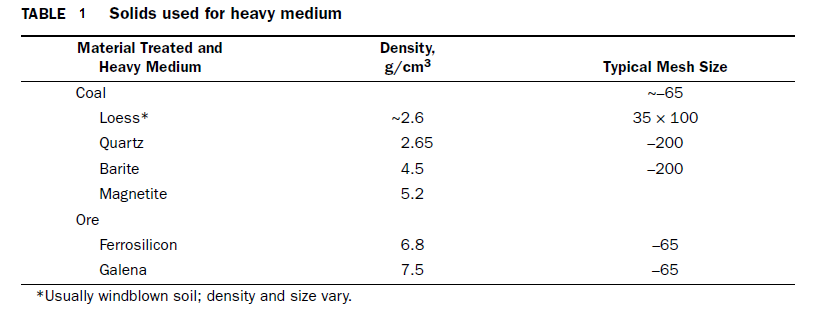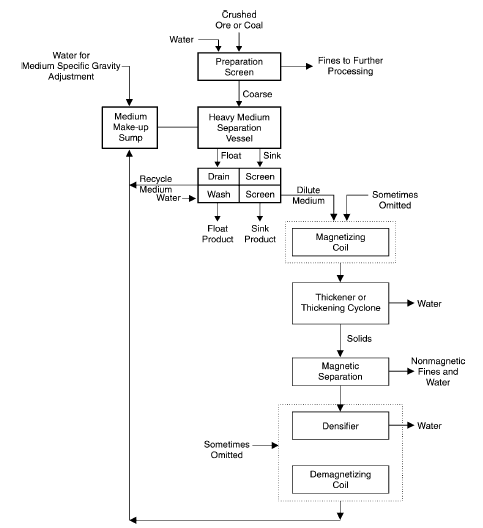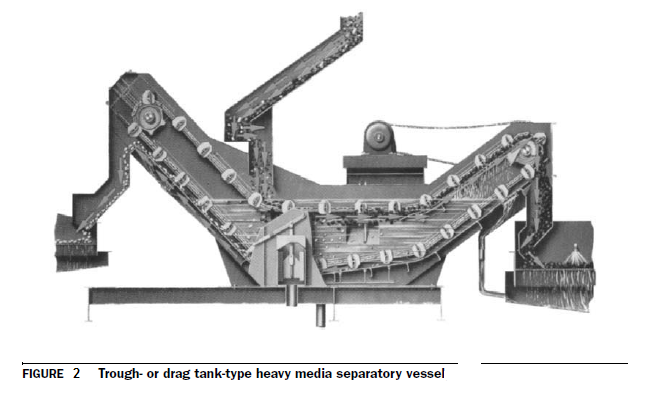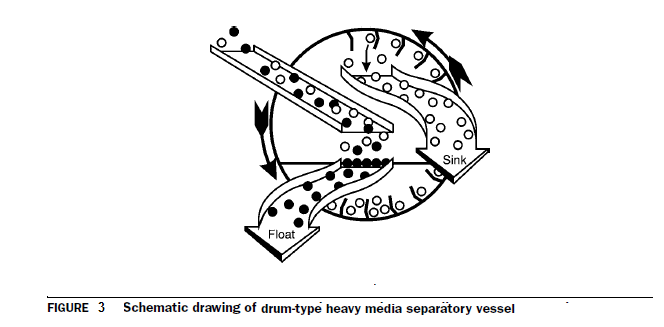As a important way of gravity separation, Heavy media separation (HMS) has been used industrially to
---Produce a finished concentrate and a rejectable waste in one operation
---Reject a relatively coarse waste leaving an enriched product ready for further processing (a step that can greatly reduce expensive grinding costs)
---Produce a finished concentrate and a lower-grade product ready for further processing
---Produce two finished products of differing composition
Ordinarily, HMS is used for the first two of these functions—the first for coal, the second for ores.
The most successful way to achieve a float–sink separation has been to use a quasi-stable suspension of a solid that is appreciably heavier than the mineral to be floated. Various solids have been employed to make an aqueous heavy media suspension (Table 1). Silica sand in an inverted conical vessel is used in the Chance Cone system,. Because this suspension is relatively unstable, particular care must be used to keep the sand in suspension. The sand is separated from the coal and refuse by water sprays and screening. Although this process is not used in newer plants, several Chance Cone plants still exist today. Barite finely ground to facilitate suspension stability was formerly used in a few plants. Loess in a hydrocyclone separatory vessel has been used to separate coal from refuse. Today, finely ground magnetite is the medium of choice for coal cleaning. Its fine particle size gives good suspension stability, and its excellent magnetic properties greatly facilitate its removal from the separated products.

Ores, such as those of the base metals of copper, lead, and zinc, were first separated from their associated gangue minerals using a readily available galena (ρ = 7.5) flotation concentrate (–65 mesh) as the heavy medium. Galena has been largely supplanted by 15% Si-ferrosilicon (ρ = 6.8), easily made
in an electric furnace. The cold-furnace product is ground to about –65 mesh, or, for higher gravity separations, the molten metal is steam shotted to produce spherical particles. It is strongly ferromagnetic. An idiosyncracy of magnetite and ferrosilicon is the variation in the size consist of these media, because
ferrosilicon (either ground or shotted) contains only a small proportion of fines. For example, a nominal –65-mesh (–208-μm) ground magnetite may contain about half –325-mesh (–44-μm) material, whereas a ground ferrosilicon of the same nominal top size will contain only about a quarter –325-mesh material. At –10 μm, ground magnetite may contain 20% or more fines, whereas ferrosilicon will contain only about 5% fines. The finer the size consist, the more stable the suspension.
A typical flowsheet for the treatment of coal or ore in a magnetic medium is given as Figure 1.
The principal features of this process are
---Preparation of feed
---Separation in heavy medium
---Removal of medium from products
---Reclamation and recycle of medium

FIGURE 1. Typical heavy media flowsheet
Preparation of Feed.
Raw coal or ore feed is typically prepared by wet screening (Figure 1). The purpose is twofold: to prepare a feed size range that is compatible with the separatory vessel to be used and to remove fine particles that would otherwise contaminate the medium suspension and thereby lower its specific gravity and increase its viscosity.
Separation in a Heavy Medium
Variety of separatory vessels has been used for HMS: inverted cones and pyramids, Akins spiral classifiers, trough-type vessels (also called drag tanks) (Figure 2), rotating drums (Figure 3), and hydrocyclones. The choice of the vessel is related to the nature of the feed to be treated, the medium and its inherent stability at the suspension specific gravity to be used, and, to some extent, the wishes of the plant operators and design engineers. Generally, the coarsest fractions, such as 51/2 in. (127–12.7 mm), are treated in a pseudostatic bath in a drag tank or in a drum vessel. The capacity of heavy media vessels that treat coarse materials is highly variable and depends on the vessel type and size, the nature and size of the feed, and the amount of float or sink products to be removed. Cone vessels can handle up to 300 tph, whereas drums and trough or drag tank vessels can treat tonnages as high as 700–800 tph. Very small tonnages can be treated in small, commercially available vessels.
The heavy media hydrocyclone usually treats particles in the size range 38 mm–0.5 mm (11/2 in.–1/50 in.), although under certain conditions it can treat material as fine as 100 mesh (150 μm). Coal preparation plants, especially, will commonly have both a heavy media drag tank and hydrocyclone separating vessels. A heavy media hydrocyclone is similar in design to a classifying hydrocyclone, and it can also process large volumes. A 26-in. (660-mm) diameter cyclone can accommodate upward of 2,000 gpm (about 7,600 L/min) while treating 135 mtph coal (Table 2). The heavy media cyclone is usually installed at an angle of about 20° from the horizontal. This angle allows the sink and the float products to be discharged at roughly the same elevation, and thus it allows the product drain and rinse screens to be installed at the same level in the plant. A similar device is the cylindrical Dynawhirlpool Separator (. It is used much less frequently than the heavy media hydrocyclone.



Removal of Medium from Products
The bulk of the medium is removed from the float and the sink products on separate wedge-wire vibrating screens of about 35 mesh. The first part of the screen, which has its own sump underneath, is called the drain section. Medium removed here is still at the separation specific gravity and is returned to the separatory vessel. The second section, which contains overhead sprays, removes any remaining medium still clinging to the particles. It is placed directly over a dilute-medium sump, and the medium is recovered from the bulk of the water and from undersize float–sink particles by magnetic separation.
Reclamation and Recycle of Medium
Usually two stages of wet magnetic drum separation are used to ensure nearly complete capture of the magnetite or ferrosilicon. As initially developed, the magnetic separators were preceded by a magnetizing coil to help flocculate the medium for easy settling and thickening. Currently, the magnetizing coil is commonly omitted. The thickener is also sometimes omitted, but it is more commonly retained not only to eliminate water but also to store medium during a plant shutdown or upset. A simple, annular alternating-current step coil surrounds the exit pipe that carries medium coming from magnetite separation. The coil facilitates deaggregation of the medium particles, as does shear during pumping. For ores, which require media of much higher specific gravity (2.6–3.85), a spiral classifier or similar device is used to thicken the medium after magnetic separation. For coal, which is cleaned in a much lower specific-gravity (about 1.5) suspension, this step is invariably omitted. Loss of medium during processing is generally in the range of 0.1–0.5 kg/t treated.